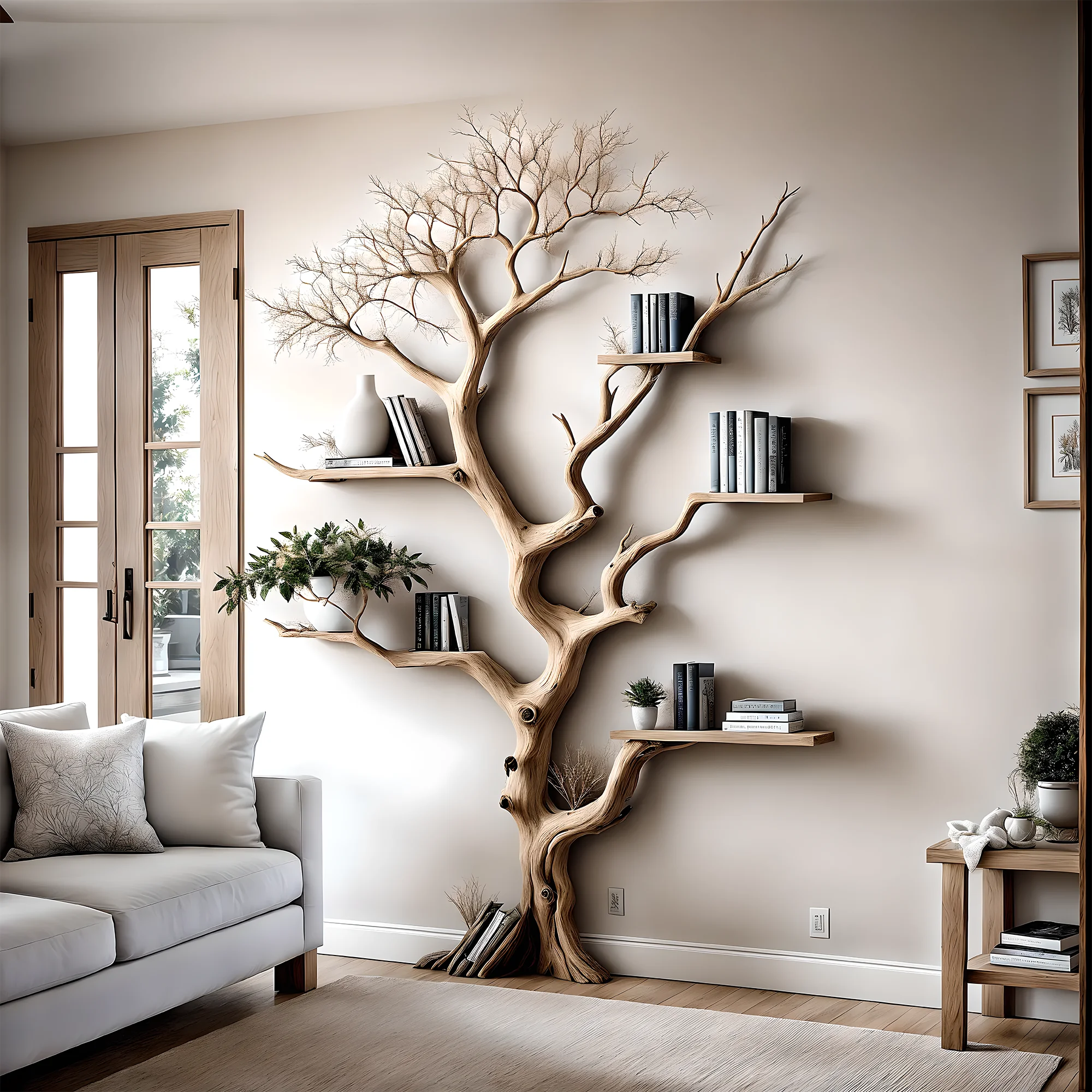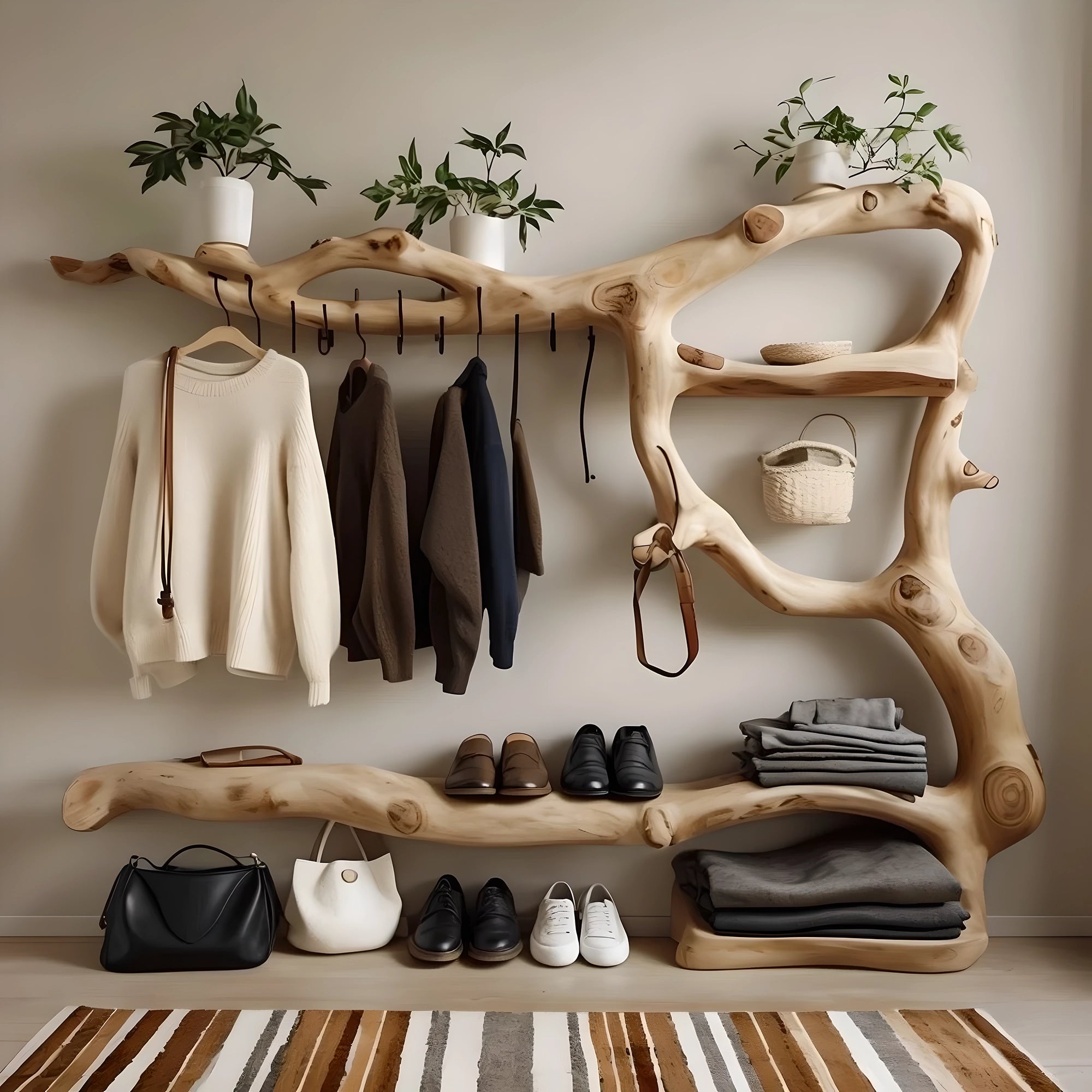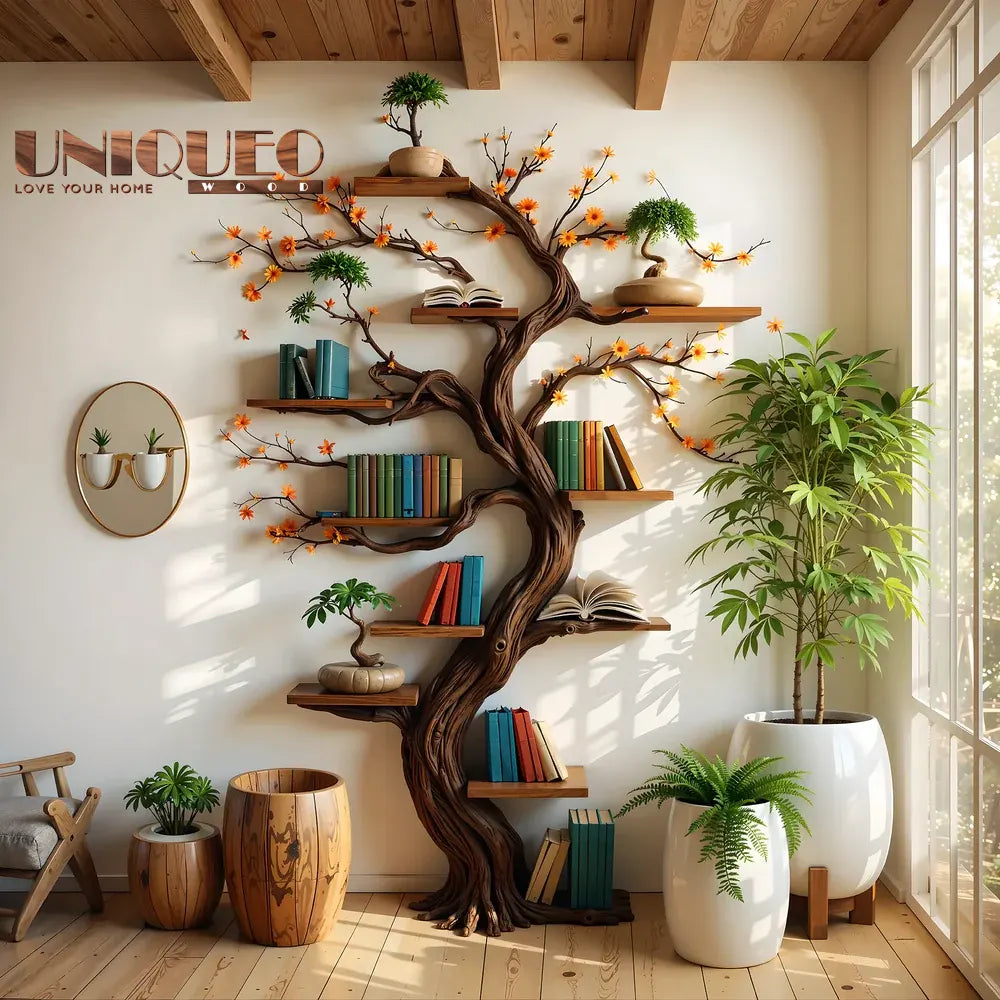
Floating Corner Shelves: Optimize Dead Corners, Add Aesthetics to Your Space
The hidden corners of your home don’t have to be empty. Floating corner shelves turn those forgotten corners into useful, attractive features. Unlike regular shelves, these designs fit perfectly into those often-unused 90-degree corners.
The appeal of hanging corner shelves is their two-in-one benefit. They solve storage problems while also making your room look better. These shelves make your space appear larger by drawing your eyes upward and using up otherwise empty vertical space.
With their sleek design and lack of exposed shelves, floating corner shelves add a modern touch to any room. They’re perfect for small apartments, cozy studios, or anywhere where every inch counts. Whether it’s for displaying photos in the living room or storing spices in the kitchen, these shelves prove that even the smallest, most awkward corners can be useful.


Check it out: Natural wooden art branch bookshelf
Key Takeaways
- Corner floating shelves transform unused angles into functional storage areas
- They create visual interest while solving practical space problems
- No visible brackets give these shelves a clean, modern appearance
- Hanging corner shelves draw the eye upward, creating the illusion of more space
- These shelves work in any room, from kitchens to living rooms to bathrooms
- They're especially valuable in small spaces where every inch counts
What Is a Corner Floating Shelf and Why You Need One
A corner floating shelf turns unused corner spaces into useful storage. It also adds visual appeal to your home. Unlike regular shelves, these attach to wall corners, making them seem to float.
Definition and Basic Structure
Corner floating shelves fit perfectly into room corners. They have an L-shaped or triangular design to use the corner space well. The mounting system is hidden, giving the shelf a floating look. A wood floating shelf adds both strength and beauty, fitting many interior styles.
The basic structure includes:
- Strong internal brackets or cleats that support weight
- Wood construction that varies in thickness (typically 1-2 inches)
- Corner-specific angle cuts for perfect wall fitting
Space-Saving Benefits
Most homes have unused corner spaces. Each corner is about 4 square feet of potential storage. A wood floating shelf turns these areas into useful storage without taking up floor space.
Visual Appeal and Design Impact
Corner floating shelves look great and are practical. They have clean lines and no visible hardware, making them seem to float. A wood floating shelf adds warmth and texture to corners, enhancing any room.
Interior designers often suggest corner shelving. It balances rooms with odd shapes or draws the eye up in low-ceilinged spaces. The wood's natural grain adds depth and character to overlooked areas of your home.

Check it out: Natural wooden art branch bookshelf
The Evolution of Corner Floating Shelves in Modern Interior Design
Corner wall shelves have changed a lot since they first appeared in homes. They started as simple storage spots but now they're key design elements. In the past, they were just wooden cabinets in corners.
The Victorian era brought fancy corner shelves with detailed carvings and many levels. These fancy shelves showed off wealth and style but were still attached to walls. Later, in the mid-20th century, shelves became sleek and angular, showing the influence of modern design.
The big change happened in the early 2000s with the rise of floating shelves. These shelves looked like they were floating without any visible supports. Designers started using different materials like glass, metal, and concrete for these shelves.
Design is not just what it looks like and feels like. Design is how it works. Corner shelving perfectly embodies this philosophy by transforming forgotten spaces into functional art.
Social media changed how we style corner shelves. Pinterest and Instagram filled with creative ideas. Now, shelves come in many shapes and styles, making corners interesting.
| Era | Corner Shelf Style | Primary Materials |
| Victorian (1830s-1900s) | Ornate étagères | Dark woods, brass |
| Mid-Century (1940s-1960s) | Angular, functional | Teak, walnut |
| Contemporary (2000s-Present) | Floating, minimalist | Mixed materials, reclaimed wood |
Today's corner wall shelves show how far we've come in design and technology. They're not just useful; they're also stylish. What was once overlooked is now a key part of our homes.

Check it out: Natural wooden art branch bookshelf
Key Benefits of Installing Corner Floating Shelves in Your Home
Many homes have unused corner areas that collect dust. A wood corner shelf turns these spots into useful storage. It also improves your home's look while solving practical issues.
Maximizing Unused Corner Space
These shelves fit corners that regular shelves can't. By adding a wood corner shelf, you make the most of unused space. The unique design fits perfectly, adding storage where there was none.
Creating Optical Illusions in Small Rooms
Corner shelves can make small rooms look bigger. When placed at different heights, they make the room feel larger. Dark corners become highlights, adding depth to small spaces.
The beauty of a well-placed wood corner shelf lies in its dual nature - it solves storage problems while making the entire room feel more spacious and intentionally designed.
Versatility Across Different Rooms
Corner shelving is great for any room. In kitchens, they hold cookbooks and spices, keeping counters clear. In bathrooms, they store toiletries without taking up floor space. Living rooms can display plants, photos, or collectibles, making the space personal.
Cost-Effective Storage Solution
Wood corner shelves offer great value. They cost less than most storage furniture but are just as useful. This affordable option brings both function and style without the high price of custom built-ins.

Check it out: Natural wooden art branch bookshelf
Choosing the Perfect Wood Floating Shelf for Corner Spaces
Choosing the right wood shelves for corner spaces is important. You need to think about materials, finishes, and support. The best shelf looks good and works well, turning unused corners into beautiful spots.
Popular Wood Types and Their Characteristics
Each wood type gives a unique look to your shelves. Oak is durable and has a strong grain, great for busy areas. Pine is affordable and looks light and casual. Walnut has deep, dark colors for elegant rooms.
Maple is smooth and takes paint well. Bamboo is eco-friendly and resists moisture.
Finish Options and Their Impact on Room Aesthetics
The finish you choose greatly affects your room's look. Clear polyurethane keeps wood looking natural and protected. Stains highlight the wood's grain and match other furniture.
Painted finishes let you pick any color, matching or contrasting with walls. Oil-rubbed finishes give a warm, aged look that gets better with time.
Weight Capacity Considerations
Corner shelves have special needs. For light items, thin shelves with basic brackets are fine. But for books and collectibles, thicker shelves with strong brackets are needed.
The type of bracket matters more than the wood. Hidden brackets support 15-30 pounds, while visible ones can hold 50+ pounds. Shelf depth and weight must match to avoid sagging or falling.

Check it out: Natural wooden art branch bookshelf
Corner Wall Shelves: Different Styles and Configurations
Corner wall shelves come in many styles to match any home. L-shaped shelves fit well in 90-degree corners, offering lots of storage. Zigzag shelves add a fun touch with their unique lines, great for modern homes.
Rounded shelves give a softer look by avoiding sharp edges. They work well in spaces that blend old and new. Geometric shelves, like triangles or honeycombs, add a touch of architecture while keeping things practical.
The material of the shelves also changes how they look. Wooden shelves warm up industrial areas, while metal and glass give a clean look. Rustic wood adds charm with its natural look. Scandinavian designs use light woods to brighten up corners.
Multi-tier shelves turn corners into display areas. These shelves show off different items in a neat way. New designs use hidden brackets, making shelves seem to float in space.
DIY Installation Guide for Your Corner Floating Shelf
Installing a wood floating shelf in corner spaces might seem tough. But, with the right steps, it's a simple weekend project. This guide will help you get a pro-looking result without spending a lot.
Tools and Materials You'll Need
Getting ready is key when mounting a wood floating shelf. Make sure you have these important items before you start:
- Stud finder
- Drill with the right bits
- Level
- Measuring tape
- Pencil for marking
- Wall anchors that can hold your shelf's weight
- Screws that fit your mounting hardware
- Wood floating shelf with mounting bracket
Step-by-Step Installation Process
Here's how to install your corner shelf safely:
- Mark where you want your shelf on both walls at the corner
- Find wall studs near your spot with a stud finder
- Put the mounting bracket in place and mark where to screw
- Drill holes for your screws or anchors before you screw them in
- Attach the bracket to the wall with the right fasteners
- Slide your shelf onto the bracket
- Make sure it's level and adjust if needed
Common Installation Mistakes to Avoid
Many DIYers make these easy-to-fix mistakes. Avoid using weak anchors that can't hold your shelf's weight. Always find wall studs, as drywall can't handle heavy shelves. Also, be careful with corner measurements, as they often don't form perfect 90-degree angles.
When to Call a Professional
While many can install a wood floating shelf themselves, some situations need a pro. Get help if your walls are concrete or brick, your shelf is over 30 pounds, or you need it to fit with other built-ins perfectly. Pros have the tools and know-how for tricky corners that might be hard for beginners.
Creative Styling Ideas for Your Wood Corner Shelf
A wood corner shelf can turn hidden spots into eye-catching areas. The right decor can make these shelves stand out, showing off your style.
Minimalist Arrangements
Styling a wood corner shelf with simplicity is key. Choose three to five items that differ in size and texture. Pair a tall vase with a small photo and a stone.
This setup lets the wood's natural beauty shine. The empty space between items adds to the shelf's appeal.
Plant Display Options
Corner shelves are great for plants. Use hanging plants like pothos on top shelves. For lower shelves, pick small plants like ZZ plants.
Pots in terracotta or white ceramic look good with wood shelves. They add color and texture.
Book and Media Organization
Turn your shelf into a mini library. Arrange books flat and standing to add interest. This makes your books look good and keeps them organized.
You can also hide small speakers or devices among the books. This adds function without making it look cluttered.
Seasonal Decoration Tips
Change your shelf decor every few months to keep it fresh. In spring, use fresh flowers and soft colors. Summer is for beachy items like shells.
Fall is for warm colors and small pumpkins. Winter brings tiny lights and greenery. Keep a stash of seasonal items to swap out easily.
Hanging Corner Shelf vs. Traditional Shelving: A Comparison
Hanging corner shelves offer unique benefits over standard wall shelving. They turn unused angles into useful display spots, perfect for small spaces. These shelves fit well where walls meet, using space that's often wasted with regular shelves.
Traditional shelves are great for holding heavy items and are easy to install. They spread weight over longer walls, making them good for heavy books. Their straight design also makes it easier to find studs and mount them properly.
Hanging corner shelves are better for looks and saving space. They create a striking focal point and keep floors clear. By placing them in corners, they highlight often overlooked areas and add interest without taking up too much wall space.
Customization is different for each type. Traditional shelves come in standard sizes and mounting systems, making them easy to replace. Corner shelves need more precise measurements but offer tailored solutions that make the most of every inch. When choosing, think about your needs for weight, space, and looks, as one style may not fit all.
Maintenance and Care Tips for Wood Shelves Floating in Corners
Keeping wood shelves floating in corners in good shape is key. With the right care, they can stay beautiful for many years. They become a highlight in your home.
Regular Cleaning Routines
Dust builds up fast on wood shelves in corners, especially in tight spots. Clean them weekly with a microfiber cloth to stop dust from piling up. For a deeper clean, use a mix of mild dish soap and warm water on a soft cloth.
Don't soak the wood, as it can harm the finish. Dry it well after cleaning to avoid water spots.
Preventing Damage and Wear
Use felt pads under heavy items to avoid scratches on the shelves. Keep shelves away from direct sunlight to prevent fading. You can also apply UV-protective finishes.
Place coasters under drinks and don't put hot items directly on the shelves. Check the mounting hardware every six months to keep it secure.
Refinishing and Restoration Techniques
If your shelves look worn, try light sanding with fine-grit sandpaper. Sand with the grain for the best results. Apply wood polish or wax every 3-4 months to keep them shiny.
For bigger damage, take off the shelf and strip the old finish. Then, apply a new stain and protective coating. Small touch-ups with wood markers can fix minor dings without a full refinish.
Conclusion: Transform Your Space with the Perfect Corner Floating Shelf
The corner floating shelf is a great way to make any room look better. It's perfect for using up space in corners, making small rooms look bigger, or adding a modern touch. These shelves are easy to install and can really change how your home looks.
Choosing the right wood corner shelf can make your space look better and work better. You can use them to store things or show off your favorite items. Whether you like simple designs or something more creative, there's a shelf for you.
Think about how you can use those hidden corners in your home. A corner shelf can turn these spots into stylish and useful parts of your space. With a bit of creativity and the right shelf, you can make your home look amazing.

Check it out: Natural wooden art branch bookshelf
FAQ
What is a corner floating shelf?
A corner floating shelf is a special wall-mounted shelf for corners. It fits perfectly into the corners of a room. This shelf makes the most of unused space, giving you more room for storage and display without using floor space.
What are the benefits of installing a corner floating shelf?
Corner floating shelves have many benefits. They: - Use up space in corners - Make small rooms look bigger - Work well in many rooms (like kitchens and living rooms) - Are a cheaper way to store things than buying furniture
What materials are used for corner floating shelves?
Corner floating shelves are often made from wood like oak, pine, and walnut. These natural materials add warmth and fit many design styles. The type of wood and finish can change how the shelf looks and how much it can hold.
How do I install a corner floating shelf?
To install a corner floating shelf, follow these steps: 1. Get your tools and materials ready, like a drill and wall anchors. 2. Find the wall studs in the corner where you'll mount the shelf. 3. Mark where to drill and make pilot holes. 4. Attach the shelf's mounting hardware to the wall, making sure it's level. 5. Put the shelf on the hardware and check that it's secure.
How can I style and decorate a corner floating shelf?
There are many ways to decorate a corner floating shelf. You can: - Keep it simple with a few items - Add plants for a natural look - Organize books and media - Change up the decor with the seasons
How do corner floating shelves compare to traditional wall shelving?
Corner floating shelves have some big advantages over regular shelves. They: - Use up corner space - Look clean and minimalist - Need special installation for corners - Can hold more weight and be more stable when mounted right
How do I maintain and care for my wood corner floating shelf?
To keep your wood corner floating shelf looking good, do the following: - Clean it regularly to avoid dust - Protect the wood from water and sun damage - Refinish or restore it when needed to keep it looking great






